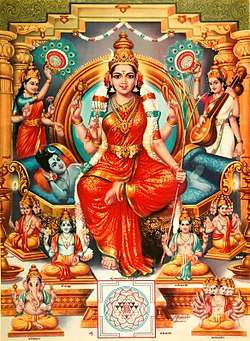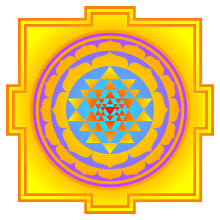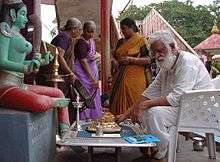Shakti
Shakti (Devanagari: शक्ति, IAST: Śakti; lit. "Energy, ability, strength, effort, power, capability"[1]) is the primordial cosmic energy and represents the dynamic forces that are thought to move through the entire universe[2] in Hinduism, and especially Shaktism, a major tradition of Hinduism.
| Shakti | |
|---|---|
The divine energy | |
 | |
| Other names | Adi Parashakti, Parvati , Mahadevi, Kali, Durga, Devi, Sati |
| Affiliation | Devi, Parvati |
| Weapons | All |
| Personal information | |
| Siblings | Vishnu |
| Consort | Shiva |
Shakti is the personification of the Energy that is creative, sustaining, as well as destructive, sometimes referred to as "The Great Divine Mother" in Hinduism. Also known as Mahaamaya (The Greatest Delusion), it is just a metaphor of energy, which no layman or scientist has ever been able to decipher - we see energy in all forms all around us. Everything is just a manifestation of energy, but what exactly energy is, no one knows - hence energy is the greatest delusion i.e. Mahaamaya.
As the Mother or Creatrix, She is known as "Adi Shakti" or "Adi Para Shakti" (i.e., Primordial Inconceivable Energy). On every plane of creation, Energy manifests itself in all forms of matter, thermal energy, potential energy, gravitational energy etc. These are all thought to be infinite forms of the Paraa Shakti. But Her true form is unknown, and beyond human understanding. She is Anaadi (with no beginning, no ending) and Nitya (forever).
Hindus believe that Shakti is both responsible for creation (Shakti makes Srishti) and the agent of all change. Shakti is cosmic existence as well as liberation, its most significant form being the Kundalini Shakti, a mysterious psychospiritual force.[3][4]
In Shaktism, Shakti is worshipped as the Supreme Being. Shakti embodies the active dynamic energy of Shiva (as Devi Shivaa/Shive) and is synonymously identified with Tripura Sundari or Parvati.
Evolution
| Part of a series on |
| Shaktism |
|---|
 |
|
Schools |
|
Festivals and temples |
|
|
David Kinsley mentions the "shakti" of Lord Indra's as Sachi (Indrani), meaning power.[5] Indrani is part of a group of seven or eight mother goddesses called the Matrikas (Brahmani, Vaishnavi, Maheshvari, Indrani, Kaumari, Varahi and Chamundi or Narasimhi), who are considered shaktis of major Hindu gods (Brahma, Vishnu, Shiva, Indra, Skanda, Varaha/Yama and Narasimha respectively).

The Shakti goddess is also known as Amma (meaning 'mother') in south India, especially in the states of Karnataka, Tamil Nadu, Kerala, Telangana, and Andhra Pradesh. There are many temples devoted to various incarnations of the Shakti goddess in most of the villages in South India. The rural people believe that Shakti is the protector of the village, the punisher of evil people, the cure of diseases, and the one who gives welfare to the village. They celebrate Shakti Jataras with great interest once a year. Some examples of Shakti incarnations are Mahalakshmi, Kamakshi, Parvati, Lalita, Bhuvaneshwari, Durga, Meenakshi, Mariamman, Yellamma, Poleramma, and Perantalamma.
One of the oldest representations of the goddess in India is in a triangular form. The Baghor stone, found in a Paleolithic context in the Son River valley and dating to 9,000–8,000 years BCE,[6] is considered an early example of a yantra.[7] Kenoyer, part of the team that excavated the stone, considered that it was highly probable that the stone is associated with Shakti.[8]
Shaktism

Shaktism regards Devi (lit., "the Goddess") as the Supreme Brahman itself with all other forms of divinity considered to be merely Her diverse manifestations. In the details of its philosophy and practice, Shaktism resembles Shaivism. However, Shaktas (Sanskrit: शक्त, Śakta, ), practitioners of Shaktism, focus most or all worship on Shakti, as the dynamic feminine aspect of the Supreme Divine. Shiva, the masculine aspect of divinity, is considered solely transcendent, and Shiva's worship is usually secondary.[9]
From Devi-Mahatmya:
By you this universe is borne, By you this world is created, Oh Devi, by you it is protected.[10]
From Shaktisangama Tantra:
Woman is the creator of the universe, the universe is her form; woman is the foundation of the world, she is the true form of the body.
In woman is the form of all things, of all that lives and moves in the world. There is no jewel rarer than woman, no condition superior to that of a woman.[11]
Adi Parashakti
Adi Parashakti, whose manifestation is Parvati and Tripura Sundari, is a Hindu concept of the Ultimate Shakti or Mahashakti, the ultimate power inherent in all Creation. This is especially prevalent in the Shakta denomination within Hinduism, which worships the Goddess Devi in all her manifestations. Her human or Shakti Svarūpa (powerful form), Parvati, was married to Shiva, while her Gyān Svarūpa (knowledge form), Saraswati, weds Brahma and her Dhan Svarūpa (wealth form), Lakshmi, becomes the consort of Vishnu.
Smarta Advaita
In the Smarta Advaita sect of Hinduism, Shakti is considered to be one of five equal personal forms of God in the panchadeva system advocated by Adi Shankara.[12]
Shakti Peeths
According to some schools, there are four Adi Shakti Pitha and 51 Shakti centers of worship located in South Asia (four Adi Shakti Pitha are also part of 51 Shakti pithas but they are four major parts of Devi Sati's body. So, they are adi shakti pithas). They can be found in India, Sri Lanka, Nepal, Bangladesh, Tibet and Pakistan. These are called Shakti Peethas. The list of locations varies. A commonly accepted list of Shakti Peethas and their temple complexes includes:
- Hinglaj Mataji Balochistan
- Tara Tarini (Brahmapur, Odisha)
- Katyayani (Chattarpur, Delhi)
- Bhadrakali (Kodungallur, Kerala)
- Kamakhya (Assam)
- Kali at Kalighat (Kolkata, West Bengal)
- Guhyeshwari Temple Devi (Kathmandu, Nepal)
- Ambaji (Gujarat)
- Vishalakshi Temple (Varanasi)
- Chandranath Temple (Sitakunda, Bangladesh)
- Jwalaji (Himachal)[13]
- Naina Devi Temple (Uttarakhand)[14]
- Mangala Gauri (Bihar)
Other pithas in Maharashtra are:
- Tuljapur (Jagdamba)
- Kolhapur (Mahalaxmi)
- vani-Nashik (Saptashrungi)
- Mahurgadh (Renukamata)
Bhajans and mantras
There are many ancient Shakti devotional songs and vibrational chants in the Hindu and Sikh traditions (found in Sarbloh Granth). The recitation of the Sanskrit mantras is commonly used to call upon the Divine Mother.
Kundalini-Shakti-Bhakti Mantra
- Adi Shakti, Adi Shakti, Adi Shakti, Namo Namo!
- Sarab Shakti, Sarab Shakti, Sarab Shakti, Namo Namo!
- Prithum Bhagvati, Prithum Bhagvati, Prithum Bhagvati, Namo Namo!
- Kundalini Mata Shakti, Mata Shakti, Namo Namo!
Translation:
- Primal Shakti, I bow to Thee!
- All-Encompassing Shakti, I bow to Thee!
- That through which Divine Creates, I bow to Thee!
- Creative Power of the Kundalini, Mother of all Mother Power, To Thee I Bow![15]
"Merge in the Maha Shakti. This is enough to take away your misfortune. This will carve out of you a woman. Woman needs her own Shakti, not anybody else will do it... When a woman chants the Kundalini Bhakti mantra, God clears the way. This is not a religion, it is a reality. Woman is not born to suffer, and woman needs her own power."
- ~ Yogi Bhajan (Harbhajan Singh)[16]
See also
Notes
- Monier-Williams, Monier. "Monier-Williams Sanskrit-English Dictionary". University of Washington.
śaktí f. power, ability, strength, might, effort, energy, capability
- Sacred Sanskrit words, p.111
- The Shambhala Encyclopedia of Yoga, p.162
- The Shambhala Encyclopedia of Yoga, p.270
- Hindu Goddesses: Visions of the Divine Feminine in the Hindu Tradition by David Kinsley page 17, minor vedic Goddesses
- Insoll, Timothy; Insoll, Timothy (2002). Archaeology and World Religion. Routledge. p. 36. ISBN 9781134597987.
- Harper, Katherine Anne; Brown, Robert L. (2012). Roots of Tantra, The. SUNY Press. p. 39. ISBN 9780791488904.
- Kenoyer, J. M.; Clark, J. D.; Pal, J. N.; Sharma, G. R. (1983). "An upper palaeolithic shrine in India?". Antiquity. 57 (220): 93. doi:10.1017/S0003598X00055253.
- Subramuniyaswami, p. 1211.
- Klostermaier, Klaus K. (1989). A Survey of Hinduism. NY, NY: State University of New York. pp. 261 (fn 1 p 473).
- Bose, Mandakranta (2000). Faces of the feminine in ancient, medieval, and modern India. New York: Oxford University Press. p. 115. ISBN 0195352777. OCLC 560196442.
- http://www.himalayanacademy.com/resources/books/dws/dws_mandala-02.html
- Jwalaji
- Naina Devi Temple
- Yogi Bhajan as quoted in the Conscious Pregnancy Yoga Teacher's Manual by Tarn Tarn Kaur, Espanola, New Mexico p. 79
- Yogi Bhajan as quoted in the Conscious Pregnancy Yoga Teacher's Manual by Tarn Tarn Kaur, Espanola, New Mexico
Further reading
- Datta, Reema; Lowitz, Lisa. Sacred Sanskrit Words, Stonebridge Press, Berkeley, 2005.
- Feuerstein, Georg. The Shambhala Encyclopedia of Yoga, Shambhala Publications, Boston, 2000.
- Harish, Ranjana; Harishankar, V. Bharathi. Shakti: Multidisciplinary Perspectives on Women's Empowerment in India, New Delhi, Rawat, 2003, ISBN 81-7033-793-3.
- McDaniel, June (2004). Offering Flowers, Feeding Skulls: Popular Goddess Worship in West Bengal. Oxford University Press.
- Shaw, Miranda. Passionate Enlightenment: Women in Tantric Buddhism, Princeton University Press, New Jersey, 1994
- Tiwari, Bri. Maya. The Path of Practice: A Woman's Book of Ayurvedic Healing, Motilal Banarsidass Press, 2002
- Woodroffe, John. Shakti and Shakta, Forgotten Books, 1910. ISBN 1-60620-145-X.
- Woodroffe, John, Woodroffe, Ellen (trans.). Hymns to the Goddess, Forgotten Books, 1952 ([1913]. ISBN 1-60620-146-8.
- Woodroffe, John.Hymn to Kali: Karpuradi Stotra, Forgotten Books, 1922. ISBN 1-60620-147-6.
External links
| Wikiquote has quotations related to: Shakti |

